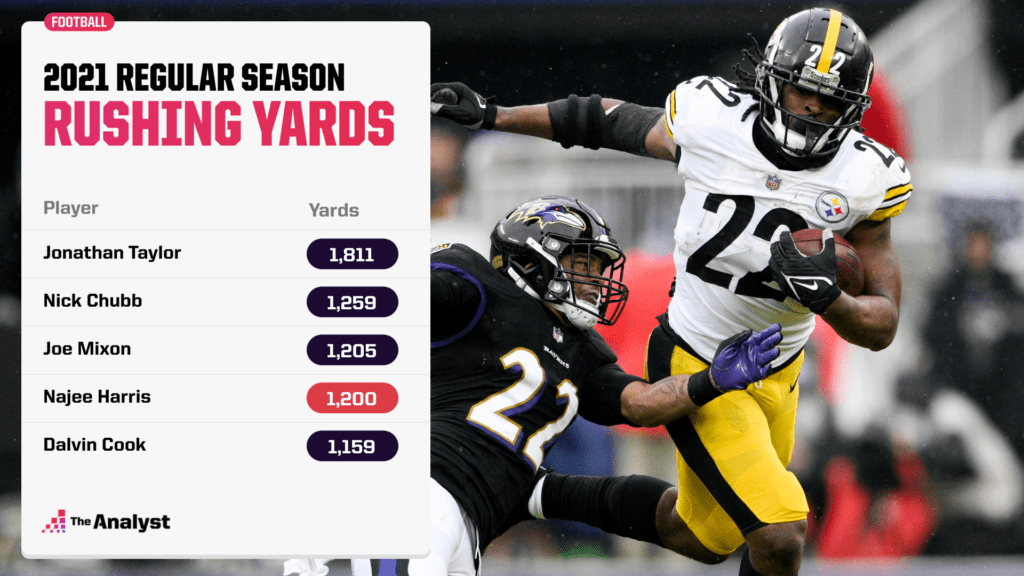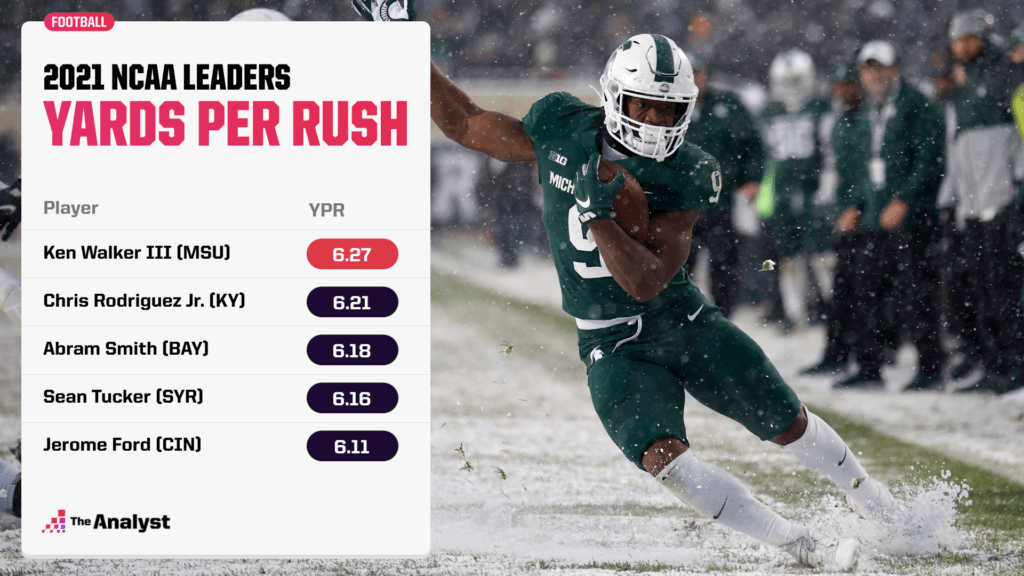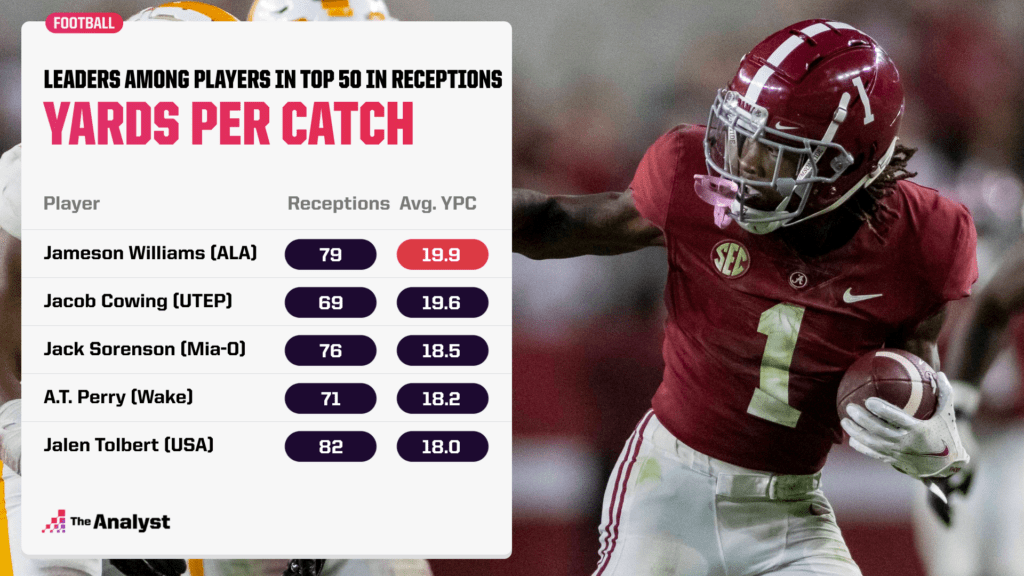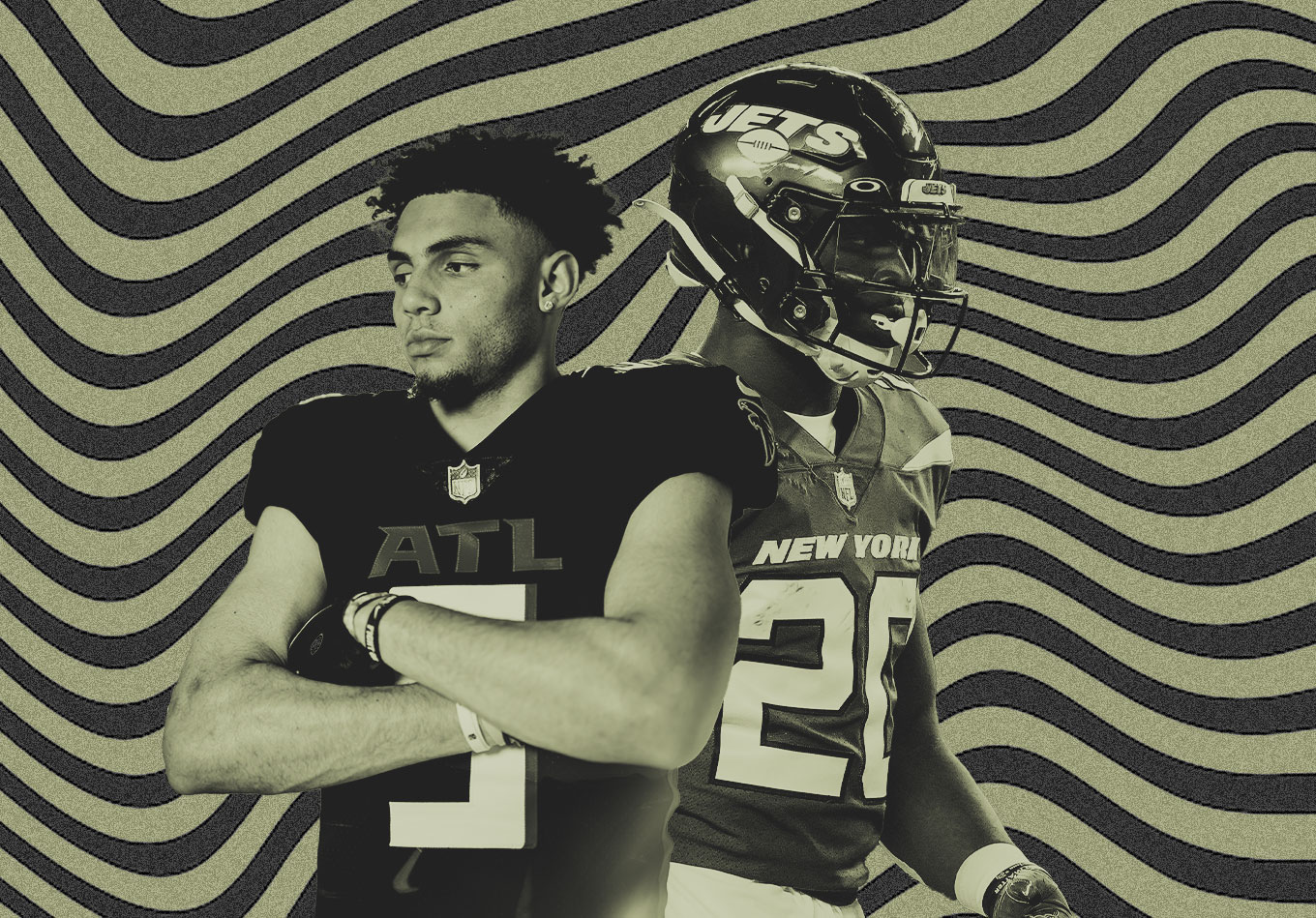Fantasy Football Rookie Quick Hits
- Running Back Ranks: Breece Hall (RB27), Kenneth Walker II (RB33), James Cook (RB61)
- Wide Receiver Ranks: Drake London (WR50), Garrett Wilson (WR60), Chris Olave (WR68), Jameson Williams (WR78), Jahan Dotson (WR57), Treylon Burks (WR44)
- Sign of Things to Come: Hall led all of college football with 70 forced missed tackles in 2021.
Preseason football is in full swing, which means it’s time for wild overreactions and declarations about your favorite players and teams.
Of course, it’s also a time for the rookies to don new uniforms, begin their football journeys, and, if all goes well, show their fan bases that maybe, just maybe, they are on their way to becoming the next Peyton Manning or Jerry Rice.
Like, for example, Najee Harris, who showed flashes of brilliance throughout training camp and the preseason. He had Pittsburgh Steelers fans thinking they’d found their feature back for the next eight years, and they just might have.
Harris had a breakout rookie season, finishing fourth in the NFL in rushing yards on his way to an RB3 finish.

Great preseasons, however, don’t always come to fruition. Ja’Marr Chase can attest to that. Remember back to just 12 months ago, people were questioning whether Chase could even catch a football. Yes, that same guy who proceeded to explode onto the fantasy scene finishing the 2021 NFL season as WR3, breaking the all-time rookie receiving yards record along the way.
Of course, he did this a year after his college teammate, Justin Jefferson had an all-time rookie season himself, finishing as WR6. Which came just one year after Kyler Murray finished his rookie season as QB7. Which came just one year after Saquon Barkley finished his rookie season as the top-scoring running back. Which came just one year after Alvin Kamara finished his rookie season as RB3.
Recent fantasy history is littered with highly successful rookies. And this newest class, with four wide receivers drafted among the top 12 picks in the NFL Draft and six first rounders overall, likely contains at least one player who will finish in the top 15 at their position. The key, as always, is attempting to decipher which player that might be before the season begins.
Let’s examine those six first-round receivers, along with the three second-round running backs and the highest-drafted tight end to discover which one might be most ready to soar to immediate fantasy relevance. (Note: All fantasy football rankings and projections are as of Aug. 24 and are subject to change as we move closer to opening kickoff.)
Running Backs
Breece Hall, New York Jets (Projection: RB27)
No running backs were selected in the first round of the NFL Draft for the first time since 2014. Meaning that with the 36th pick of the second round, Hall was the first RB to hear his name called. And just like in real life, fantasy managers are making Hall the first rookie selected in fantasy drafts.
So, who are fantasy managers getting when they draft Hall? How about a highly productive college running back who was able to combine volume and efficiency. Last season, when Harris entered the league as the undisputed top fantasy rookie, he was coming off a season in which he had led all of college football in forced missed tackles. Hall was second. This year, it was Hall that topped that list, with 70 forced missed tackles.
Now on the Jets and firmly entrenched as one of the two top backs, Hall is in a solid position to receive immediate work for an offense that likes to run the ball. Essentially, everything we said about why Michael Carter might have been a good fit last year for the Jets applies this year, only this time, the Jets heavily invested in Hall.
More than any other running back in this year’s class, Hall’s upside is as a top-12 running back.
Kenneth Walker III, Seattle Seahawks (Projection: RB33)
Of course, it wasn’t Hall who won the Doak Walker Award last season as the nation’s top running back, it was the award’s namesake that won it. After transferring from Wake Forest, Walker immediately provided a massive boost to the Michigan State Spartans, ultimately leading the Spartans to an 11-2 record and a New Year’s Six appearance in the Peach Bowl.
It took Walker no time to hit the ground running, literally, exploding for 264 rushing yards and four touchdowns in the first game of the season against Northwestern. He never looked back and ended up leading all college running backs with 210 or more carries in yards per rush.

Walker ended up as the second running back selected in the NFL Draft, heading to a Seattle Seahawks team that lost Chris Carson to retirement in the offseason. With Carson gone, Walker’s main competition for a heavy workload is Rashaad Penny, who ended last season on a tear rushing for more than 135 yards in four out of his last five games.
However, Penny has only played more than 10 games in one of his four seasons as a pro and despite his success on the ground, Penny finished 33rd among all running backs in yards after contact per rush (1.97).
Meanwhile, facing excellent competition in the defensively loaded Big Ten, Walker excelled after contact, rushing for 2.52 yards per carry after contact on his way to scoring 18 touchdowns. He may not walk in and be the immediate starter on Day 1, but Walker will almost certainly have a plethora of chances to take over the lead-back role in an offense that is going to look to run the ball a lot with Russell Wilson now in Denver.
James Cook, Buffalo Bills (Projection: RB61)
Dalvin Cook’s younger brother, James, has maybe the highest ceiling and the lowest floor of all rookie running backs. Let’s start with the good: He was drafted by the third highest scoring offense from a season ago and despite their obvious offensive successes, the Bills have not been enamored by either of their incumbent running backs, Devin Singletary or Zack Moss.
Meanwhile, Cook was extremely productive with his touches. He averaged 6.5 yards per carry for his career in college, in addition to being the most productive pass-catching back on his team, something the Bills have lacked. To boot, neither Singletary nor Moss have ever had a season averaging more than 18 receiving yards per game. There is absolutely room for Cook to become an immediate impact player.
Now the bad: Despite his productivity, Cook was never the lead back at Georgia and the history of backup running backs in college becoming successful in the NFL is few and far between. Therefore, overcoming two established backs that know the offense seems highly unlikely. Currently with an ADP of 115, if you’re looking for a high upside player, Cook, if everything goes right, could be a league-winner. He might also be someone you drop after three weeks.
Pass Catchers
Drake London, Atlanta Falcons (Projection: WR50)
The first receiver drafted in the 2022 NFL Draft, London is a big, strong 6-foot-4 receiver out of USC heading to a team that, well, let’s nicely say, doesn’t have a ton of wide receiver talent on the depth chart. London, therefore, unlike every other receiver on this list, immediately steps in as the No. 1 wide receiver on his team.
That type of role won’t be new to London. On his Trojans team last season, London was targeted on a remarkable 42.4% of his routes, by far the most in college football among all players who had at least 50 targets. He wasn’t open on a lot of those targets either. London led all of college football last season in receptions (16) on catchable balls while not open.
All of which makes London a great bet to lead rookies in targets (he’ll likely finish second on his team in targets to Kyle Pitts). In fantasy, opportunity and volume are gold (especially in PPR leagues) and London is in line to get a lot of both. He is the surest bet to be fantasy relevant this season.
Garrett Wilson, Jets (Projection: WR62)
Wilson began the run of three straight Ohio State receivers picked in a row when he was selected with the 10th pick. He enters a situation in the NFL quite the opposite of London. Wilson has tons of competition in the wide receiver room for both targets and playing time. Elijah Moore, Corey Davis and Braxton Berrios are all back for another year in the same offense, making Wilson’s path to playing time murkier than other receivers on this list.
Therefore, if you’re drafting Wilson, you’re betting on Wilson’s oozing talent pushing him to the forefront of the group. Wilson’s burn percentage (72.5) was sixth amongst all receivers with 100 targets and he forced a missed tackle at the fourth highest rate per touch amongst the same group. Put simply, Wilson gets open, and he can force tacklers to miss once he gets the ball.
As part of the extraordinarily talented wide receiver room in Columbus, Wilson is no stranger to being successful in an offense that spreads the ball around. While he likely won’t dominate targets like some of his draft-mates, he might be the best prepared to take advantage of his opportunity.
Chris Olave, New Orleans Saints (Projection: WR57)
Last year, we said that if everything broke his way, Chase might be the player to rival Justin Jefferson’s rookie numbers. That player this year might be Olave. Seven of Olave’s 13 reception touchdowns last season went for more than 30 yards, and Olave’s deep ball tracking and overall ability meshes perfectly with Jameis Winston’s quarterbacking style.
Using 100 targets as the cutoff to find the higher volume players, Olave ranked fifth in average depth of target (14.3). As part of the top-scoring offense in college football last season, Olave had more touchdowns (13) than games played (12) on his way to breaking Ohio State’s all-time career receiving touchdowns mark.
Joining fellow Ohio State alum Michael Thomas and Jarvis Landry in New Orleans, Olave is part of an improved Saints receiving core that could be one of the better groups in the NFL. Defenses won’t be able to send all their attention to any one receiver, and that could be the recipe for Olave to burst onto the NFL scene.
Jameson Williams, Detroit Lions (Projection: WR78)
Williams was the third receiver in the stacked Buckeyes receiver room until he transferred to Alabama in search of more playing time and opportunity. Boy did that decision ever pay dividends.
Williams pulled off his best DeVonta Smith impersonation, providing big play after big play for the Crimson Tide offense. Williams led all players with 100 or more targets in big-play percentage (48.1), which measures how often a player produced an opportunity for a big play. That big-play ability was present the entire season, as Williams led the top 50 players in receptions last season in yards per catch (19.9).

Williams will likely begin the season completing his recovery from a torn ACL suffered during the national championship game. Situated on a Lions offense with Amon Ra St. Brown and T.J. Hockenson manning the short to intermediate areas of the field, Williams’ ability to take the top off a defense should pay immediate dividends once he’s able to get back on the field.
Our model projects him to be more productive than George Pickens of the Pittsburgh Steelers, Christian Watson of the Green Bay Packers (despite having Aaron Rodgers at QB) and Skyy Moore of the Kansas City Chiefs (even with Patrick Mahomes throwing to him).
Jahan Dotson, Washington Commanders (Projection: WR59)
Dotson got better every season at Penn State, culminating in a 91-catch, 1,182-receiving yard masterpiece of a senior season for the Nittany Lions. He almost scored half (12) of the total receiving touchdowns (25) for the entire team last season.
He heads to a Commanders squad with an established star in Terry McLaurin and the ability to cement himself as the WR2 in that offense. Dotson arrives in the NFL with a reputation for being surehanded after only dropping one pass last season despite 91 receptions. That led to Dotson ranking first amongst all drafted receivers in catch rating (0.978), which is a weighted score we produce to measure one’s catching skills.
Mistakes will get rookies off the field in a hurry. Dotson, who makes very few, will have plenty of opportunities to impress his new team and quarterback.
Treylon Burks, Tennessee Titans (Projection: WR44)
Burks was the last of the six first-round receivers, but fantasy managers are grabbing Burks early. He’s currently going off the board as the second rookie receiver, just behind London. Why? Well, for starters, the Tennessee Titans traded their star receiver, A.J. Brown, to the Eagles for the 18th pick in the draft, which immediately became Burks.
This means that like London, Burks enters a situation with immediate playing time and passing volume available to be won. With only Robert Woods – coming back from a torn ACL – to fight with for targets, Burks is in a prime fantasy position. More so than that, however, Burks led all college football players with at least 50 receptions in yards after the catch per reception (9.27). That number would have ranked second amongst all NFL receivers last season, behind only YAC king Deebo Samuel.
He may have been the last of the first-round receivers, but don’t mistake that for a lack of talent. Burks is our highest projected rookie receiver entering the regular season. If you grab him as the first rookie taken in your fantasy football draft, you might just have bragging rights over your friends forever.
Trey McBride, Arizona Cardinals
Let’s quickly close out with the top tight end selected in this year’s draft. McBride is coming off a season that ended by being named the Mackey Award winner for the top tight end in the nation. He was the only player in the top 25 in receiving yards per game to be a tight end. However, he enters the NFL sitting behind Zach Ertz in the Cardinals’ tight end pecking order and therefore is only really a sleeper for fantasy managers playing in a dynasty format.
Data modeling by Kyle Cunningham-Rhoads. All ADP is from Fantasy Pros.
